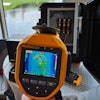Research conducted by Fluke Corporation plus interviews with leading educators and trainers point to the importance of extensive hands-on training to meet employers’ needs for industrial, electrical, and HVAC technicians.
After a considerable drop in job opportunities through the depths of the recession, the outlook for technical jobs has turned positive. According to The U.S. Bureau of Labor Statistic’s Occupational Outlook Handbook 2012-2013, growth in HVAC and electrical jobs will grow at two-to-three times the average growth forecasted and industrial plant technician jobs will grow at the average rate of 11 percent.
While that is a positive trend in the marketplace, employers report a shortage of qualified candidates to fill entry-level jobs. Eighty-five percent say it is difficult to very difficult to find entry-level workers with acceptable skills—for industrial positions that number grows to 93 percent. More than half of the employers surveyed said job candidates lack enough years of on-the-job experience to effectively perform in their positions. And while the majority report that their new hires have basic electrical test tool knowledge, they are looking for job candidates with more hands-on experience, troubleshooting expertise, and “soft skills” like problem-solving abilities. What does the opportunity look like then, for a fresh graduate with school-level training, if employers only have room on their teams for experienced candidates?
Exacerbating the situation is the quickening pace of baby boomer professionals retiring. While there is contradictory evidence of how quickly that attrition is happening, some industries are having difficulty just maintaining the current number of people in jobs. The Air Conditioning, Heating, and Refrigeration Institute (AHRI), says its industry currently needs 27,000 new workers each year just to replace those who retire.
These trends point to a significant opportunity to educate and train a new crop of industrial, electrical, and HVAC professionals—an opportunity universities, unions, and training centers are jumping on and tailoring to the needs of employers. The programs of those surveyed require an average of 2,117 hours (just over one work year) of hands-on experience to graduate from their programs, and some require considerably more. Sixty-one percent said their program included on-the-job training and 97 percent say their programs include hands-on training with electrical test tools.
The number of potential new hires is increasing as well. Fifty-three percent of the educators polled said enrollment in their programs has increased over the past five years.
There’s also recognition of the need for continuing education. Ninety percent of workers surveyed say the definition of their jobs is broader than when they started, so continuous learning has become a necessity. While the majority of respondents had participated in accredited continuing education, with 62 percent sponsored or paid for by their employers, they reported that on-the-job mentoring had not increased, indicating a possible opportunity for more organized forms of in-house knowledge transfer.
On the link between test tool skills and employability, 82 percent of respondents said test tool knowledge was more important now than it was when they entered the field. And while 55 percent of professionals polled indicated they were satisfied with their current skill level with test tools, 54 percent said it would help them to learn more.
Marketable skills-training must take place both on-the-job and at school. For employers to find the level of quality they seek, they may need to take a more active role in creating apprentice-style programs, designed to create both breadth and depth of knowledge, as well as increase continuing education programs to help the existing workforce adapt to and take advantage of changes in technology.
Study Results:
Job Markets Expected To Grow
According to The U.S. Bureau of Labor Statistic’s Occupational Outlook Handbook 2012-2013, growth in HVAC jobs is forecast to grow at 34 percent—three times the average predicted occupational growth rate. Electrician jobs are forecast to grow at a 23 percent rate while industrial plant maintenance technician jobs are forecast to grow at the study’s average of 11 percent.
According to the Bureau of Labor Statistics study, because of the growing complexity of HVAC systems, “employers generally prefer applicants with post-secondary education or those who have completed a formal apprenticeship.” The growth in electrician jobs is predicted because “homes and businesses require more wiring than ever before, and electricians will be needed to install the necessary components.”
Workforce Creeping Toward Retirement
According to the Fluke Corporation 2012 Workforce Study, 90 percent of workers surveyed say the definition of their jobs is broader than when they started. Eighty percent say test tool knowledge is more important than it used to be and 54 percent say it would help them to learn more about test tools. Of those respondents, 58 percent would like to learn more about advanced meter functions.
Fifty-five percent have been in their current profession more than 20 years, and 68 percent have been in it 15 years or longer. Yet, retirement is still a ways off. Of those surveyed, 77 percent are more than five years away from retirement.
Finding Qualified New Hires Is Tough
Of employers surveyed, 85 percent report it is difficult to very difficult to find entry-level workers with acceptable skills. Industrial employers found it slightly harder (93 percent) than their electrical and HVAC counterparts (85 percent).
Thirty-eight percent say candidates lack an applicable degree or certification; 53 percent say they lack enough years of on-the-job experience, with the average minimum required experience expected at 3.4 years.
Yet 95 percent of the educators and trainers surveyed said students that graduate from their programs possess enough skill using electrical tools to meet entry-level qualification.
New Hires Need Experience
Of the employers surveyed, 66 percent say their new hires have basic electrical test tool knowledge, but need more hands-on time. Ninety-five percent say competency in basic electrical theory and electrical safety is a basic requirement to do the work and increases productivity on the job, while 75 percent expect knowledge of electrical panel troubleshooting.
Employers are also looking for “soft skills,” such as problem-solving ability, strong work ethic, attention to detail (all ranked at 14 percent), and the ability to be productive independently (12 percent).
Responses indicated a need for troubleshooting and problem-solving skills, compared to the lower-level requirements for installation tasks. Eighty-four percent of industrial employers stated the ability to troubleshoot electromechanical equipment such as motors and pumps was important; 84 percent of HVAC employers stated the ability to maintain and troubleshoot motors, pumps, and fans was important.
Hands-On Education
Sixty-two percent of the programs of the educators and trainers interviewed in the survey are two or four year programs. The educators and trainers in the survey report an average of 2,117 hours (just over one work year) of hands-on experience are required to graduate from their programs. Union programs require as much as 10,000 hours (5 work years). Sixty-one percent of educators said their program included on-the-job training.
Ninety-seven percent of educators say their programs include hands-on training with electrical test tools. Forty percent of students surveyed say their hands-on training takes place in the field or on the job; 51 percent say it takes place in hands-on labs.
Why the different points of view between the employers and educators surveyed? While the study provides no data on employer hiring practices, a recent article from the Star Tribune[1]may suggest an answer. The article notes that despite a rise in demand for skilled workers, low pay scales have barely budged. Companies that have successfully survived the recession have become more specialized and hire workers with more skills at a higher wage. Perhaps the graduates with 2,000–8,000 hours of experience are being hired by companies paying a higher wage, while the majority of employers in this study are trying to hire workers with very basic skills at the lowest possible hourly wage. This is worthy of future investigation.
There is also strong anecdotal evidence that new graduates are not able to employ their higher skill levels immediately out of school because they are put into menial, single-focused positions. So not only do they lose the skills gained in school through lack of use, they also do not get the kind of rotational experience that would make them a valuable, in-depth employee.
Continuing Education As A Priority
While only 51 percent of employers provide official on-the-job training (on-boarding, mentoring, etc.), 64 percent of employees have participated in accredited continuing education. Of those, 62 percent of the continuing education was sponsored or paid for by their employers showing strong support for their employees’ continuing education. And many employers are willing to let employees use work time for their continuing education. Thirty-three percent of continuing education during work hours was in-person; 15 percent was online.
Methodology
In June 2012, Fluke Corporation fielded a comprehensive, voluntary survey of industry professionals, educators, and employers to study workforce trends, to help ensure the Fluke Education Program matches today’s training needs. Survey invitations were sent by e-mail to an extensive list of prospects. When it was closed in July, 1,608 people had completed the survey. In addition, third-party resources (i.e. The U.S. Bureau of Labor Statistic’s Occupational Outlook Handbook 2012-2013) were tapped to provide supporting trend data. The goal of this research effort was to survey the views of test tool users, educators, trainees and hiring managers to determine current workforce trends.
[1] Adam Belz, “The skills gap: Myth or reality?,”Star Tribune, August 5, 2012























